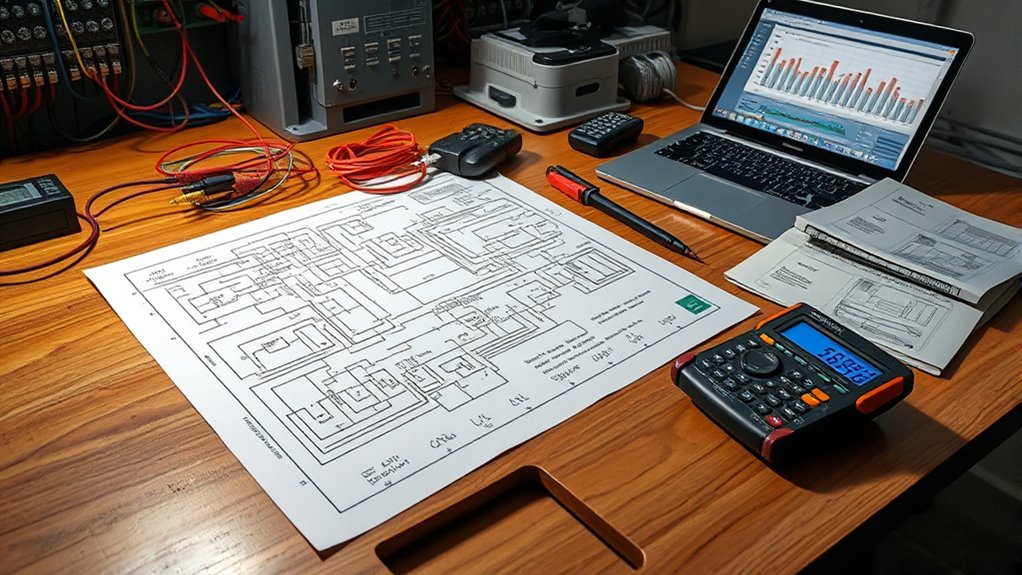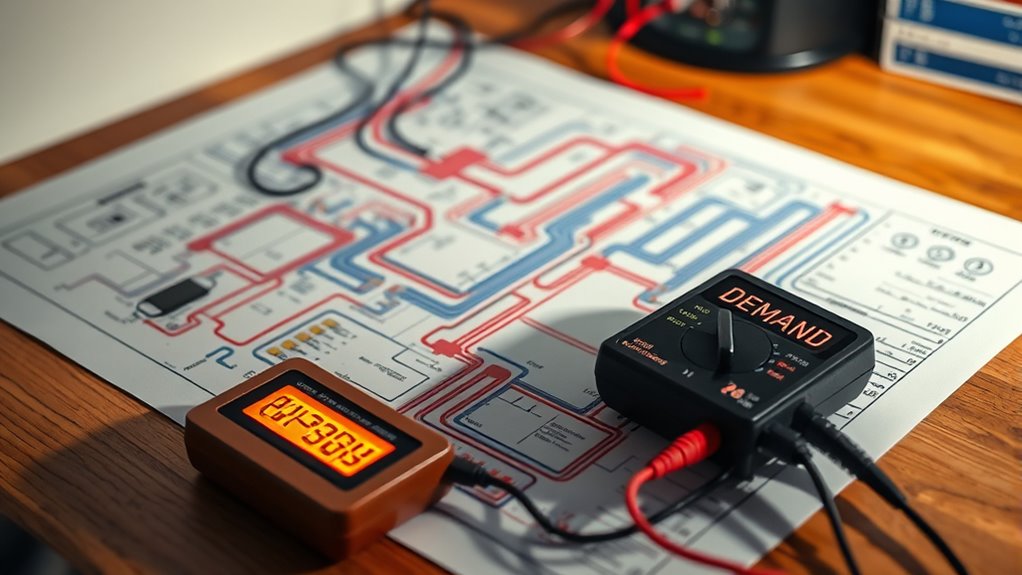To accurately calculate load for each circuit, you must first sum the power ratings of connected devices and modify for power factor. Then, apply appropriate demand factors and diversity adjustments to determine the maximum demand. Always verify that wire sizes match the calculated loads and share load evenly across circuits. Proper planning ensures safety, efficiency, and compliance—stay with us to explore detailed steps and expert tips that make these calculations straightforward.
Key Takeaways
- Sum all connected device power ratings and adjust for power factor for accurate real load calculation.
- Apply demand and adjustment factors to account for simultaneous usage and prevent overestimating load.
- Ensure conductor sizing matches the calculated load and complies with NEC ampacity requirements.
- Perform branch circuit calculations considering load diversity to select appropriate overcurrent protection.
- Verify overall system safety and code compliance through proper load analysis and balanced circuit design.
Understanding the Basic Components of Load Calculations

Have you ever wondered what goes into calculating electrical load? It’s essential to understand key components like power factor and load diversity. Power factor measures how efficiently your electrical system uses electricity; a high power factor means less wasted energy. When calculating load, you must consider load diversity, which accounts for the fact that not all devices run simultaneously at full capacity. This helps prevent overestimating the total load, ensuring your system isn’t oversized or undersized. Properly factoring in power factor can also influence equipment sizing and energy savings. Load diversity allows you to adjust calculations based on real-world usage patterns, making your estimates more accurate. Additionally, understanding curiosity’s role in exploring electrical concepts can lead to more innovative and efficient designs. Mastering these components helps you create reliable, cost-effective electrical systems that meet your needs without unnecessary excess.
Calculating the Connected Load for Each Circuit

To accurately determine the connected load for each circuit, you need to identify all devices and appliances connected and sum their individual power ratings. Remember, the power factor affects the real power consumption, so adjust your calculations accordingly. Not all devices run at full load simultaneously, which is where load diversity comes into play; it helps you avoid overestimating the circuit’s capacity. When calculating, consider the rated wattage and the power factor to find the true load. Be precise in listing every connected device, including lighting, outlets, and motor loads. Additionally, understanding the importance of guidance and support from experienced electricians can help ensure your calculations are accurate, preventing undersized or oversized circuits, and supporting safe, efficient electrical system design.
Determining the Demand Factors and Adjustments

After calculating the connected load for each circuit, you need to account for variations in actual usage. This is where demand factors come into play. The demand factor reflects how much of the connected load is typically used at once, helping you avoid overestimating your capacity needs. To adjust the calculated load, you apply an adjustment multiplier, which accounts for diversity and usage patterns. By multiplying the connected load by the demand factor and then by the adjustment multiplier, you determine the maximum expected demand. This process ensures your electrical system is accurately sized, preventing undersizing or oversizing. Properly applying demand factors and adjustment multipliers makes your load calculations more realistic and reliable, ultimately leading to safer, more efficient electrical designs. Understanding industry trends can further improve your planning and system efficiency.
Applying Circuit and Branch Circuit Calculations

How do you guarantee your circuits are properly sized and protected? First, analyze the circuit’s total load, considering the power factor to ensure accurate current calculations. Next, perform branch circuit calculations by applying the correct conductor sizing based on the increased or decreased load; remember, a poor power factor can lead to undervalued conductor sizes. Finally, verify that your calculations meet the NEC requirements for overcurrent protection and conductor ratings. To summarize:
- Adjust load calculations for power factor to determine true current.
- Select conductors with ampacity ratings suitable for the calculated load.
- Ensure overcurrent devices match the conductor size and load demands.
This approach guarantees safe, efficient operation and compliance with electrical codes.
Verifying Code Compliance and Safety Margins

Ensuring your electrical installations meet code requirements is essential for safety and reliability. Verify that your wire sizing aligns with the calculated load to prevent overheating and potential hazards. Proper wire sizing ensures that conductors can handle the current safely, maintaining the safety margins specified by codes. Additionally, check for load balancing across circuits to avoid uneven distribution, which can lead to overloads or inefficient operation. Use the correct wire gauge and ensure circuits are properly rated for the expected load. Regularly inspect your setup to confirm compliance with local codes and standards. Being aware of Security Zone Info can help you understand the importance of protecting your electrical systems from potential threats. By verifying wire sizing and load balancing, you not only meet legal requirements but also enhance system durability and safety, giving you peace of mind in your electrical installation.
Frequently Asked Questions
How Often Should Load Calculations Be Reviewed and Updated?
You should review and update load calculations regularly, ideally every 3 to 5 years, or whenever there’s a significant change in your electrical system. This guarantees load validation and maintains safety compliance. Keep an eye on any modifications to your equipment or usage patterns, as these can impact your load calculations. Staying proactive helps prevent overloads and ensures your system remains safe and compliant with current standards.
What Tools or Software Are Best for Load Calculation Accuracy?
Coincidentally, the best software tools for load calculation accuracy include programs like SKM PowerTools, ETAP, and EasyPower. These tools help you perform precise calculations, analyze system performance, and ascertain compliance. You should choose software that offers real-time updates, user-friendly interfaces, and extensive reporting features. By using reliable tools, you’ll improve your load calculations’ accuracy, save time, and reduce errors—making your electrical system safer and more efficient.
How Do Load Calculations Differ for Residential Versus Industrial Circuits?
You’ll find load calculations differ for residential and industrial circuits mainly because of power factor and circuit diversity. In residential settings, power factors are typically high, so calculations are straightforward. Industrial circuits often have lower power factors and higher circuit diversity, requiring adjustments for efficiency. You must account for these factors to guarantee accurate load estimates, prevent overloads, and optimize energy use across different circuit types.
What Are Common Mistakes to Avoid in Load Calculation Processes?
Don’t forget, even in your calculations, to avoid common mistakes like ignoring power factor and load diversity. You might think these are minor, but they greatly impact accuracy. Overlooking them can lead to undersized or oversized circuits, risking safety and efficiency. Always double-check your assumptions, especially when estimating load, and make certain you apply appropriate diversity factors. This way, your calculations stay precise, preventing costly errors down the line.
How Do Future Expansions Impact Current Load Calculations?
Future expansions substantially impact your current load calculations by requiring you to take into account future capacity planning. You should factor in potential increases in demand, additional circuits, and equipment upgrades to ensure your system can handle growth. Ignoring future planning risks underestimating load, leading to inadequate capacity. Incorporate flexible design elements now, so your system remains efficient and scalable, saving you from costly modifications later.
Conclusion
So, next time you’re tempted to skip load calculations, remember—they’re not just boring chores but your secret weapon against electrical chaos. Ignoring them might save time now, but it’s like betting your house on a faulty circuit—sure to backfire. Embrace the process, double-check your work, and sleep soundly knowing your circuits won’t turn into fireworks. Because, let’s face it, nobody wants their electrical system starring in its own disaster movie.









